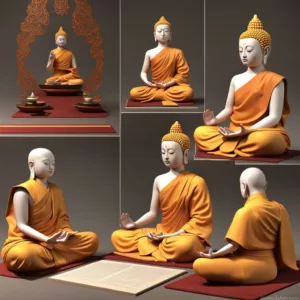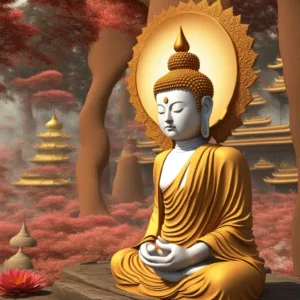
Anicca, impermanence is one of the 3 Marks of Existence. It is a core teaching and a critical contemplation on the Buddhist path. Anicca inspires us to focus on what is truly meaningful while we have the chance.
I love Anicca and impermanence contemplations. I would say that impermanence is the only thing on the path I have ‘realized.’ That means I actually see all the phenomena of my life and my life itself, as temporary. It creates a great sense of both poignance and urgency. It makes my life meaningful, which seems ironic. But it doesn’t feel ironic.
Secrets of Meditation for Anxiety
Like millions of people, you may have suffered from anxiety for years. Meditation, yoga, peaceful music – it never works. It takes too long, and it’s not stable. Why? Because peace is treated as a cause for freedom, but it’s not – it’s the result. The cause to free yourself from anxiety is completely different.
Click now to Overcome Anxiety for good.
Table of Contents
Anicca in Buddhism, Impermanence Summary
Central Concept: Anicca (Impermanence)
Context: Buddhist Philosophy
Related Concepts: Dukkha (Suffering), Nirvana, Four Noble Truths, Samsara (cycle of rebirth)
Definition: Anicca is a Pali term that translates to impermanence, unsubstantiality, or constant change. It’s a fundamental concept in Buddhism, signifying the inherent impermanent nature of all things.
Explanation:
- Anicca applies to everything in existence, from physical objects and relationships to our thoughts, feelings, and even our sense of self.
- Nothing stays the same forever. All things arise, change, and eventually cease to exist in their current form.
- Understanding Anicca is crucial for overcoming suffering (Dukkha) according to Buddhism. Clinging to impermanent things leads to frustration when they inevitably change.
Significance:
- Anicca is one of the Three Marks of Existence in Buddhism, alongside Dukkha (suffering) and Anatta (non-self).
- Recognizing Anicca allows us to let go of attachment and cultivate a more accepting and peaceful way of living.
- It motivates us to focus on the present moment, appreciating the beauty and impermanence of all things.
Connection to Other Concepts:
- Dukkha: Clinging to impermanent things (Anicca) is a root cause of suffering (Dukkha).
- Samsara: The cycle of rebirth (Samsara) is fueled by our attachment to impermanent things and the illusion of a permanent self.
- Nirvana: Liberation from suffering (Nirvana) is achieved by letting go of attachment and embracing the impermanent nature of reality (Anicca).
Note: Different Buddhist schools may have slightly different interpretations of Anicca.
How to meditate like a yogi
and enter profound samadhi
1. Introduction: Anicca, impermanence: Everything Changes – A Universal Truth
Have you ever stopped to think about how life is a constant state of flux? The seasons change, bringing new life in spring and the quiet beauty of falling leaves in autumn. We grow older, our bodies and minds transforming over time.
Even the things we hold dear aren’t immune to change. Relationships evolve, friendships shift, and cherished possessions eventually wear out or lose their luster. This constant state of impermanence is what Buddhism calls Anicca (pronounced ah-nee-cha).
Anicca isn’t just about the obvious changes we see around us. It’s a deeper truth about the nature of reality – that nothing stays the same forever. This applies to everything in existence, from the grand scale of galaxies to the most fleeting thought or feeling that flits through our minds.
2. What Does Anicca Really Mean in a deep way?
We often think of impermanence in terms of the physical world. We see the leaves changing color, our bodies aging, and objects breaking down. But Anicca goes much deeper than that.
Imagine a rushing river. The water keeps flowing, constantly changing, carrying everything with it. This is a powerful metaphor for Anicca. Our thoughts and feelings are like the water in the river – constantly in motion, arising and passing away in a never-ending stream.
Even our sense of self, the idea of a solid “me” that exists over time, is impermanent according to Buddhism. This concept is called Anatta, and it suggests that our self is more like a flowing river of experiences, thoughts, and emotions, rather than a fixed entity.
Understanding Anicca can be surprising at first, but it also holds the key to a more peaceful way of living. By acknowledging the impermanent nature of things, we can begin to let go of the anxieties and frustrations that come from clinging to what can’t last.



3. Anicca and The Root of Suffering: Clinging to the Impermanent
Have you ever felt a pang of sadness when a favorite possession breaks, or the sting of disappointment when a relationship ends? These experiences of suffering (Dukkha) are often rooted in our attachment to impermanent things.
Remember Anicca, the ever-changing nature of life? When we cling desperately to things – objects, relationships, even our own ideas of how things should be – we set ourselves up for suffering. It’s like trying to hold onto water in a cupped hand – the tighter you clench your fist, the more it slips away.
Think about that phone you’re constantly upgrading. New models come out, features change, and eventually, your beloved device feels outdated. Clinging to the idea that it should always be perfect or the best can lead to frustration. The same goes for relationships. People change, grow, and sometimes move in different directions. Clinging to a fixed image of how a relationship “should” be can cause pain when reality doesn’t match our expectations.
4. Anicca, impermanence: Letting go
The good news is that understanding Anicca empowers us to let go of this attachment. By acknowledging the impermanence of things, we can loosen our grip and cultivate a more accepting way of living.
Mindfulness practices, a cornerstone of Buddhism, play a crucial role here. Through meditation, we learn to observe our thoughts and feelings without judgment, allowing them to come and go like passing clouds. This practice helps us loosen the hold of cravings and attachments, reducing the suffering they cause.
Imagine yourself standing on the bank of a flowing river. The water keeps moving, but you’re not swept away by the current. You can appreciate the beauty of the flow without clinging to any particular drop. Embracing Anicca is like that – finding peace by accepting the ever-changing nature of life and focusing on the present moment.
The benefits are real. By letting go of attachment, we can experience less stress, anxiety, and disappointment. We become more present, appreciating the beauty and impermanence of all things. Life becomes a journey of discovery, not a desperate attempt to hold onto what can’t be held.
Sanskrit for Anicca, Impermanence
The Sanskrit word for Anicca is अनित्य (anitya).
Here’s a breakdown of the word:
- अ (a): This prefix generally means “not” or “without.”
- नित्य (nitya): This root word means “eternal,” “everlasting,” or “permanent.”
Therefore, combining these elements, अनित्य (anitya) literally translates to “not eternal” or “impermanent.” This directly reflects the meaning of Anicca, which signifies the inherent impermanence and ever-changing nature of all things in Buddhist philosophy.
Tibetan for Impermanence, Anicca
The Tibetan word for Anicca is མི་རྟག་པ་ (mi rtag pa) (pronounced mih tayk pah).
Here’s a breakdown of the word:
- མི་ (mi) – meaning “not” or “without”
- རྟག་ (rtag) – meaning “eternal,” “permanent,” or “lasting”
- པ་ (pa) – a grammatical suffix
Combined, མི་རྟག་པ་ (mi rtag pa) literally translates to “not lasting” or “impermanent,” accurately reflecting the concept of Anicca.
5. Conclusion: Anicca and Impermanence
Life, like a river, is in a constant state of flux. Anicca, the Buddhist concept of impermanence, reminds us of this ever-changing nature of reality. It applies to everything, from the grand shifts in seasons to the fleeting thoughts that flit through our minds.
Understanding Anicca might feel unsettling at first. But it also holds the key to a more peaceful and accepting way of living. By recognizing that nothing stays the same forever, we can loosen our grip on impermanent things and cultivate a sense of detachment. This doesn’t mean becoming emotionless robots, but rather learning to navigate the flow of life with greater ease.
The journey doesn’t end here. Exploring Buddhist teachings and mindfulness practices can offer valuable tools for embracing impermanence. Meditation can help us become more aware of our thoughts and feelings, allowing them to come and go without clinging. By living in harmony with change, we can experience less suffering, appreciate the present moment more fully, and find peace in the ever-flowing river of life.
So, take a deep breath, acknowledge the impermanence around you, and embrace the journey of discovery that life offers.

May all beings be happy
May all beings be peaceful
May all beings be safe
May all beings awaken to the light of their true nature
May all beings be free







